I started buying computer references back in the early 1980s. Al Gore had stubbornly not yet invented the Internet, so budding young computer enthusiasts such as myself had no other choice but resort to the dead tree version of a reference. And I bought a lot of computer books.
Over the years, I purged my library. Heck, if the Good Will won’t take any computer books older than 18 months, why should anyone keep them? Some these titles were special references, books that I figured I would look at again and again, or books that I obviously overpaid for so dearly that the thought of getting rid of them made me blanch.
Here are the highlights:
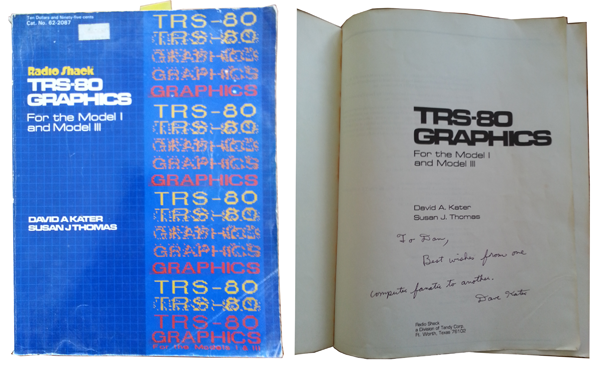
Figure 1. TRS-80 Graphics Programming by David Kater.
Back in the early 1980s, I was hungry for any and all information on programming my TRS-80 Model III. I exhausted the entire Radio Shack library of BASIC books. Then I found TRS-80 Graphics. The price tag is still on it: $10.95. Money well-spent, as you can see by the tattered cover. In fact, I met David Kater (the author) and asked him to sign the book. He was seriously impressed with how ragged the book was, providing that I really used it. (Kater and I both started our writing careers at Compusoft Publishing.)

TRS-80 Assembly Language Programming by William Barden.
After I consumed all the BASIC language programming books, I took the steep dive into Z80 Assembly Language. Barden’s Learning TRS-80 Assembly book was cheap at Radio Shack, about $4, but to me it was worth about $40. I even purchased his follow-on title that expanded my exploration of the TRS-80 and Zilog Z80 programming.
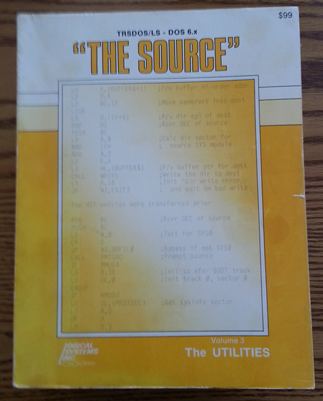
The Source, a three volume set fully documenting the TRS-DOS 6 operating system.
Above you see Volume III of The Source, the complete source code for LDOS 6, the final version of the TRS-80 operating system. This sucker cost me $99, which is probably why I’ve held onto it. I didn’t buy the complete set, which was $299. I needed only this volume, which described low-level disk access and how to program the timer. I used that information to write communications programs. But the TRS-80 was a dead-end system, so I quickly abandoned my efforts in favor of DOS on the IBM PC.
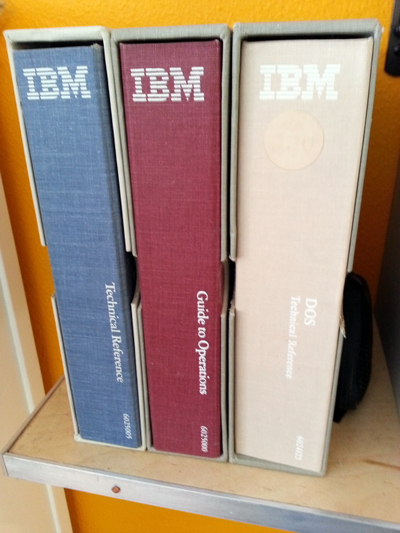
Original IBM PC reference set.
I purchased an original IBM PC (model 5150) from my employer back in 1985. Along with it, I received these references. Here you see the original three-volume technical set. This was unique documentation at the time because it described every circuit in the device. One of the three books lists the complete, commented source code for the BIOS. That’s pretty impressive.
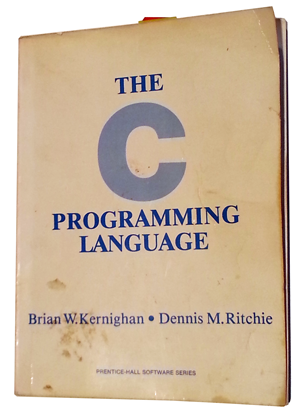
My copy of the original K&R C language reference.
Over time, I migrated from BASIC to Assembly and finally the C programming language. I picked up a copy of the classic K&R C Programming Language reference in the mid-1980s. The book is pretty tattered and I keep it because no C programmer ever gets rid of it! I even have their second edition, and still I keep the first. It’s the 20th printing, copyright 1979.

Peter Norton’s classic PC programmer’s reference.
None of the information in Norton’s classic Programmer’s Guide to the IBM PC is relevant any longer. That doesn’t mean at one time I dog-eared the tome to death! As an 8080 coder, the book was invaluable. Fortunately, I remember to take it with me when I trekked up to Santa Monica to meet with Peter Norton. I had him sign it. Like David Kater (author of TRS-80 Graphics, Norton was suitably impressed that I really used his book.
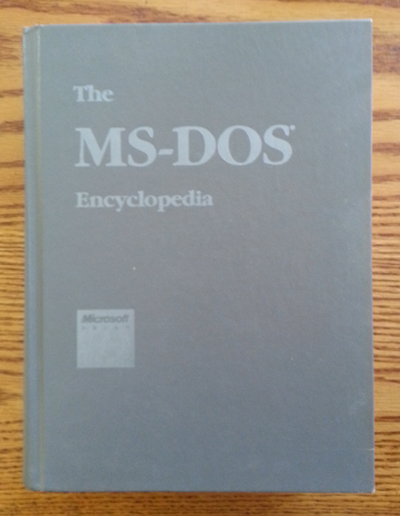
Microsoft Press’ ultimate MS-DOS guide.
One day around 1990, all my pals got an email. A mutual online friend wrote, “You have to get to a bookstore and pick up the MS-DOS Encyclopedia!” So we all did! The sucker cost $60. It was the size of a phone book, about 3-inches thick. Inside, the book completely documented DOS, all the commands, all the options, all the features — all of it. And the reading was dry as a bone.
Years later, I would be working with Microsoft Press. I passed on to them the passion my friends had about the MS-DOS Encyclopedia. They explained how genuinely surprised they were at the books’ success. They didn’t think it would sell well and had a difficult time trying to get it published. Still, it turned out very well. There was even talk of my updating the book, but it would have been too huge of an undertaking. The original editor, Susan Lammers, was completely burned out by the project.
My technical library is rich with other interesting titles I’ve hung onto. A few years ago, I purged about 200 books. My old office had room for them all, but not my new one. That’s sad, too, because those books held lots of value. It pains me to throw out any book, even an old dusty, rusty technical book.


I agree, I must admit to keeping old reference my-self, I had a load of Chip Data Books (had looked at them for years, it’s all on the web!) that got donated (?) to a Computer museum (who probably chucked them!) The oldest book I have on my computing shelves is ‘Interfacing Projects For The BBC Micro’ by Bruce Smith 1984 I knew I had a copy went looking for it as the my current non-work realated computing fad at the moment is to build a robot (that interfaces to an Adrino & a Raspberry PI but thats another story) I did remeber that book had some motor circuits in…
Comment by glennp — February 15, 2014 @ 8:53 am
When I worked at CompuSoft Publishing, the most requested title was Controlling the World with Your TRS-80. The author had written that it was to be his next book, and there was great enthusiasm for the project — but from readers not from him. The title never went anywhere. So I can see how those books you refer to, being in that time frame, would be considered something special.
Comment by admin — February 15, 2014 @ 9:09 am
The author wasn’t David A. Lien was it? I ask as that is the name commonly comes up, also I stuck ‘Controlling the World with Your TRS-80.’ into Amazon and found it unavailbe…
Comment by glennp — February 16, 2014 @ 5:23 am
Yes, that’s the book. If memory serves, one chapter was written. They got the TRS-80 to control an electronic train set. That was pretty cool.
I was in the employ of Dr. Lien for about 18 months in the mid 1980s. I was dubbed a “researcher” at first, and then the “technical director.” I would call myself a ghost writer, but the real term was staff writer. Dr. Lien explained to me that there were no ghost writers at CompuSoft. I’ll have to write a bit about my adventures there sometime….
Comment by admin — February 16, 2014 @ 8:51 am